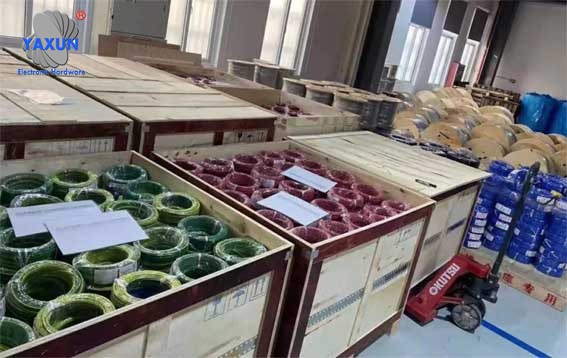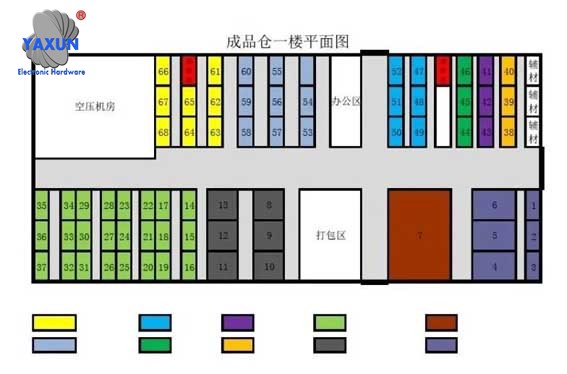For those who have not been exposed to wire harness warehouse management work, they may think that warehouse management is simply about keeping the products in the warehouse. The work content is very simple and does not have any technical content. With a deeper understanding, you will find that there is actually a lot of knowledge in wire harness warehouse management, and it is not just limited to the simple storage of materials. Let me briefly lead you to understand the management process of the wiring harness factory warehouse.
The purpose of warehouse management
Effectively plan and coordinate to prevent the loss of the company’s raw materials, other materials, semi-finished products and finished products, ensure that accounts are consistent with physical items, and improve the efficiency of storage and receipt.
2-Scope of application
Applicable to company’s raw materials, materials, semi-finished products and finished products.

Warehouse management of wire harness factory
3-Authority and Responsibility Unit
Warehouse management: Responsible for warehousing operations such as the entry, ladustamine, exit and inventory of materials, finished products and semi-finished products.
Quality Assurance Section: Responsible for the inspection of incoming materials, finished products and semi-finished products, and inspection of expired items.
Business: Responsible for communicating with customers on matters related to finished product shipments.
4- Operation process
4.1 Raw materials warehousing
The materials received by the company are divided into two types: direct delivery from suppliers and delivery from logistics companies. All material collection work is the responsibility of warehouse managers.
4.1.1 If the supplier delivers goods directly, the warehouse keeper will check the name, material model, and count the material quantity based on the supplier’s delivery note. After it is completely consistent, sign and confirm on the supplier’s delivery note according to the quality department’s qualified inspection form, enter and print the warehousing form in the ERP system, and the warehousing is completed.
4.1.2 If the logistics company delivers goods, the receiving personnel will first check the material model and quantity according to the logistics list. According to the qualified inspection form of the quality department, after confirming that it is correct, they will sign on the logistics list to receive the goods, enter it in the ERP system, and print it. Warehouse order and warehousing completed. If the quantity and specification model of the incoming raw materials do not match, storage will be suspended and feedback will be given to the procurement and supplier for verification in a timely manner. After everything is correct, go through the warehousing procedures.
4.1.2.1 Materials entering the factory to be inspected must be placed in the incoming material inspection area and must wait for inspection by the quality department before being placed in the corresponding storage location.
After receiving the materials, the warehouse manager should fill in the daily summary of the materials received in the “Warehouse Daily Report” as the basis for the accounting list.
4.1.2.2 For materials that pass the inspection, the quality assurance inspector will put a green “Qualified” label on the outer packaging of the material to show the difference, and the warehouse keeper will place the qualified products into the warehouse for positioning.
4.1.2.3 For materials that fail to pass the inspection, the quality assurance inspector will put a red “unqualified” label on the outer packaging of the material, and indicate the cause of the defect on the “Incoming Material Inspection Report”. After review by the unit supervisor, it will be transferred to the purchasing department for processing. .
4.1.2.4 When returning materials that fail the inspection, a “Return Order” should be issued and attached with a “Material Inspection Report” to require the supplier to make immediate corrections and improvements to ensure product quality.
4.2: Storage of finished products: After the finished products produced in the workshop pass the quality assurance inspection, the production unit will fill in the storage form, and the physical goods will be transferred to the warehouse after the warehouse review. Place it in the designated placement area of the finished product warehouse.
4.3: Storage and custody of materials
4.3.1 In principle, the storage and storage of materials should be planned according to the type, characteristics and use of the materials, and the inventory locations should be set up, and storage areas should be divided according to the conditions of the warehouse. Warehouse managers do a good job in organizing and rectifying the warehouse to ensure the safety of materials storage.
Storage should be mainly in plastic boxes to avoid improper stacking. The wires are packed with plastic film, the terminals are covered with paper rolls, and the rest are packed in plastic bags and stored in plastic material baskets and shelves. Stack the boxes with the top one covered with a lid to prevent dust from entering.
4.3.2 The first-in-first-out (FIFO) principle should be considered when stacking materials, so that delivery is convenient and there is room for space. The storage location should be selected in an appropriate location, well ventilated, and protected from sunlight or moisture.
4.3.3 Except for warehousing, shipping, and loading, non-warehouse personnel are not allowed to enter the warehouse without the permission of the warehouse administrator. Check the temperature and humidity of the warehouse environment twice a day and record it in the raw material warehouse temperature and humidity record sheet.

Wiring Harness Warehouse Planning Drawing
4.4 Management of expired items:
If the expired items have exceeded the shelf life and need to be re-shipped, a re-inspection application form should be submitted and submitted together with the expired items to the quality assurance unit for inspection. The storage period of items is as follows:
Finished products: 6 months
Terminal type: 12 months
Wire type: 12 months
Electronic parts: 6 months
Other auxiliary materials: 12 months
4.4.1 If the items after re-inspection are judged to be defective products, they will be processed as defective products. If the product is determined to be qualified, the quality assurance unit should re-attach the qualified label on the package and set the subsequent re-inspection frequency and final shelf life.
4.5: Outbound management
4.5.1 Delivery of raw materials and auxiliary materials
4.5.1.1 Distribute materials according to the first-in, first-out principle to avoid the generation of sluggish materials and dead inventory. Users adhere to the first-in-first-out principle.
4.5.1.2 The warehouse manager should issue materials to the workshop in strict accordance with the “Production Plan”. Warehouse managers and production management should check the model and quantity on the production material list face-to-face, and then allocate the goods to the warehouse, warehouse control sheet, and workshop statistics after confirming that they are correct. Picking time: Each workshop and process should have a fixed picking time. In case of emergency orders, materials can be picked temporarily. The workshop should make a material consumption plan in advance.
4.5.1.3 The auxiliary materials and consumables for the workshop must be prepared one day in advance. The material picking list must be filled out on site and signed by the workshop supervisor before going to the warehouse to pick up the materials.
4.5.1.4 If other departments need to pick up materials, they should fill in the picking list by themselves and go to the warehouse to pick up the materials after approval by the department supervisor.
4.5.1.5 All material vouchers should be bound into a book by the warehouse keeper and kept properly so that they cannot be lost. The vouchers should be kept for at least 3 years.
4.5.1.6 Materials must be recorded in accounts promptly after leaving the warehouse to ensure that the account quantities are in balance with the physical objects.
4.5.2 Finished product delivery
4.5.2.1 The warehouse will ship out the goods according to the model quantity based on the invoice issued by the operating department and the sales outbound order verified by the financial department. The shipping inspector of the quality assurance inspection department will check whether the model number on the delivery order is consistent with the inspection report and the actual product.
4.5.2.2 For semi-finished products transferred within the company, after passing the inspection, the workshop statistics will go through the transfer procedures, and then the warehouse will hand over to the next workshop to avoid direct transfer between workshops.
4.6 Material early warning and handling of sluggish materials
When the inventory quantity of commonly used raw materials, auxiliary materials, and consumables in the warehouse is lower than the company’s minimum inventory (ERP system settings), procurement should be notified in a timely manner for in-transit tracking or procurement preparation. After the inventory, statistical analysis should be conducted on the aging of uncommon materials. When warehouse materials have not been used for more than 12 months, a list of sluggish materials should be made for disposal.
4.7 Warehouse 5S management
The warehouse delimits responsibility areas according to the material placement area. The area where the warehouse keeper sends and receives materials is the corresponding responsible management area. Hygiene and 5S are the responsibility of the warehouse keeper.
All items in the warehouse must be placed in fixed positions in a standardized manner according to the properties and types of materials, and material identification labels must be affixed to the fixed positions for quick identification and retrieval.
Requirements for the ground area: no dirt or sewage, no dust on the materials, and no cobwebs on the surrounding walls and attachments. Things in the office area are neatly placed, office facilities are dust-free, windows are clear and clean, and the floor is clean.
Ensure there is no direct sunlight in the warehouse; good ventilation; no insect or rodent damage; and keep the warehouse environment clean and tidy.
There should be a certain fire prevention distance between each warehouse, and various fire prevention, anti-theft and other safety protection facilities should be installed.
in conclusion
Warehouse management refers to the effective control of activities such as the receipt, receipt, and balance of warehoused goods. Its purpose is to ensure the integrity of warehoused goods and the normal conduct of business activities for enterprises, and on this basis, classify and record the activity status of various types of goods. The market characteristics of automobile wiring harnesses with multiple varieties and small batches form an important production feature of frequent product replacement. Seetõttu, warehouse management is the core work of enterprise logistics management and a basic link in enterprise supply chain management. Only by continuously improving warehouse management levels, ensuring production supply, saving logistics costs, and reducing inventory capital occupation can we create good economic benefits for enterprises.
 English
English العربية
العربية Български
Български 中文(漢字)
中文(漢字) Čeština
Čeština Dansk
Dansk Eesti keel
Eesti keel Suomi
Suomi Français
Français Deutsch
Deutsch Ελληνικά
Ελληνικά עברית
עברית Magyar
Magyar Bahasa Indonesia
Bahasa Indonesia Italiano
Italiano 日本語
日本語 한국어
한국어 Latīna
Latīna Latviešu valoda
Latviešu valoda Lëtzebuergesch
Lëtzebuergesch Polski
Polski Português
Português Română
Română Русский
Русский Slovenščina
Slovenščina Español
Español Svenska
Svenska ภาษาไทย
ภาษาไทย Tiếng Việt
Tiếng Việt
